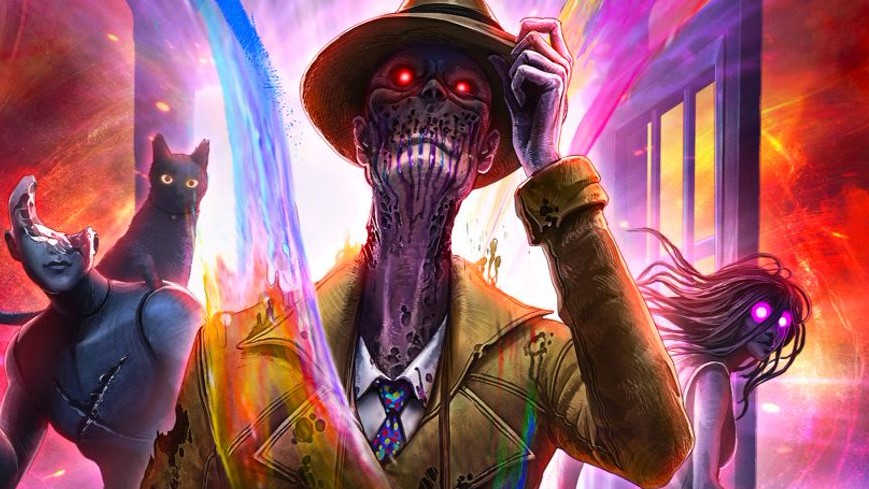
Playing through a level, you don't feel as if you are there to defeat someone. You're either there to help them, or to stop them before they hurt themselves.
The post In Sound Mind Review appeared first on 8-Bit Island.
]]>
Psychological horror games are good in theory, but only work if they really make you feel something. That feeling doesn’t always need to be fear either, and that’s what In Sound Mind manages to do so well. It’s not a constant barrage of adrenaline, but a slow build up of tension and unease. Which is all very surprising after one of the weirdest, and edgiest opening lines in a video game. But I won’t hold that against it. Much.
You play as Desmond, an amnesiac physiologist who is trying to piece together his own memories by exploring the literal psyches of his patients. Not so surprisingly, this does not go well for him. There’s also a talking cat, weird ink monsters, and noxious purple gas. In Sound Mind doesn’t shy away from the weird, and it works well in the game.
That goo isn’t good

You’ll start the game in the basement of your apartment and soon come to realise that something has gone seriously wrong in your city. The first major thing to keep an eye on is the flood of weird purple goo outside that’s completely swamped the city you live in. You also have a terrible work-life balance. But that’s to be expected when your apartment, your office, and all of your patients’ apartments are in the same building. Oh, and you’re very clearly being watched since every time you approach a phone. Like it starts ringing and the main villain takes time out of his busy day to taunt you. It’s not subtle.
The various bosses in the game are simultaneously the best and worst thing about it. The main villain is the worst for it. He calls you on the phones scattered around the level constantly, taunting you and generally being a megolamaniac. It would be effective if he didn’t sound so terribly cliché and over acted, and also wasn’t called Agent Rainbow. I find it hard to take him seriously. And then he goes and creeps around the levels so effectively that you usually only notice him when he disappears. Or when he’s standing in front of you, locking you in a freezer to die.
I find that rude, honestly.
Fight me

On the flip side, the bosses for each level are amazing. Each level is presented as a tape recording of your therapy sessions with your patients, and the main boss for each level is said patient. It doesn’t take long for you to realise when you go into a new level, that you’re heading in there to fight Desmond’s demons, as much as his patients. These are all people that have serious mental health issues that Desmond failed to help. They have become the villains of their own stories, but never really come across as completely evil.
In Sound Mind tackles the issues around mental health well. Especially in an industry that likes to either play mental illness as a joke, or a reason to be a bad person. It never comes across as disrespectful. Each of Desmond’s patients are painted as human first, mental illness second. Playing through a level, you don’t feel as if you are there to defeat someone. You’re either there to help them, or to stop them before they hurt themselves. As a reflection of this, most boss fights are more akin to puzzles that bring the bosses some measure of peace.
Delightfully unsettling

Each level is well designed, with fantastic attention to detail. The levels mix the mundane with the uncanny, so you end up with a perfectly normal supermarket that slowly turns into a haunted maze or a beach that turns to floating shipping containers. It works really well to create an uncomfortable feeling when you’re exploring a level. Each level introduces a new theme, and new tools or abilities. While the apartment allows you to calm down, the fact that you have no idea what could possibly come up in the next tape world leaves you with a delightful sense of unease.
Adding to that unease is the sheer panic of combat. Not because you’re greatly outnumbered, or underpowered, but because nothing within In Sound Mind lends itself to shooting enemies. The controls are shaky, and most of the time it’s easier to just run away rather than dealing with the annoyingly slow reload times, and Desmond’s inability to consistently point a gun at anything. Luckily, there are usually environmental hazards that can be used to your advantage. Also a shard of glass to stab things with when things start to go really wrong.
Petting cats keeps monsters away, fact

In Sound Mind tells an impressive story about people struggling with life, and throws in enough tense atmosphere, and creepy jumpscares to keep you on your toes. You’ll never know what uncanny level you’ll stumble into next, but you’ll enjoy it. It allows itself to be more than just a horror game, by being genuinely enjoyable, even as you’re creeping around trying to hide from monsters.
Also, the talking cat can be pet. This is very important.
The post In Sound Mind Review appeared first on 8-Bit Island.
]]>
I like emojis, and use them in work emails more than I probably should. So a keyboard that features a string of emojis on the side is a no-brainer. Add in a matching mouse, and my Christmas definitely came early this year. Logitech’s POP Keys and POP Mouse come in three matching designs. Daydream, Blast, […]
The post Logitech POP Keys and POP Mouse Review appeared first on 8-Bit Island.
]]>
I like emojis, and use them in work emails more than I probably should. So a keyboard that features a string of emojis on the side is a no-brainer. Add in a matching mouse, and my Christmas definitely came early this year.
Logitech’s POP Keys and POP Mouse come in three matching designs. Daydream, Blast, and Heartbreaker. None of which have very descriptive names, but all of which have surprisingly good designs. Even Blast, which is mostly a rich yellow, looks sleek and classy. I usually will pick any other colour before I pick yellow, and yet it quickly became my favourite. The dark grey and black keys contrast well with the yellow backing, and the golden escape key is a nice touch.
The POP Keys is a smaller ten-keyless keyboard that utilizes the space well. Every key is tightly tucked in with not as negative spaces as I expected from a circular key capped keyboard. The use of circular keys makes it look less cramped without leaving gaps so big that you’ll miss keys. As an extra bonus, it makes the keyboard much easier to clean. It is clearly a typewriter inspired design, and it is very pleasant to write on. All the keys are big enough to type with, and even going from a full sized keyboard to this one saw very few typos due to size difference. While advertised as a mechanical keyboard, it sounds and feels more like a mecha-membrane with softer clicks and less of a sharp sound to typing. Thankfully, it still manages to hit a satisfying click.
The POP Mouse is simple in design with the same bright colours of its corresponding keyboard. It sits nicely in the hand, and has a nice smooth design. The design that really sold it for me though, was that the whole top faceplate easily comes off when you need to change the battery, and then slips right back on with magnets. It’s simple, it’s effective and I never want to buy a wireless mouse that doesn’t use magnets to secure the battery cover ever again. That battery will also last you two years straight out of the box, thanks to an energy saver mode that activates when the mouse is idle.
Along with looking nice, the POP Mouse also has soft click buttons, meaning that you won’t hear any annoying clicks when you use it to play Minesweeper during your latest binge watching session. Is that an oddly specific example? Yes. Is it true? Also yes. Thankfully, it still has a lot of responsiveness and tactile feedback, so it feels like a solid click, even without the noise. What is strange is the combination of a soft click mouse with a mechanical keyboard, even if it acts more like a mech-membrane.
The major downside to the POP Mouse is that it is only bluetooth native. It doesn’t come with a USB dongle out of the box, but can use the same Logi Bolt USB Receiver that comes with the POP Keys. Obviously Logitech didn’t think that anyone would want just the POP Mouse, but would go for the whole set up. While it makes sense to bundle the receiver in with the more expensive keyboard, especially since that allows for a very low latency between key press and letters appearing on screen, it’s still disapointing.
Both the POP Keys and POP Mouse are easily programmable. Weirdly enough, especially considering that the emoji buttons are what makes this keyboard stand out, you do need to program them. To do this you need to download the Logi Options app, but the app itself is very easy to use, and makes the POP Keys and POP Mouse so much more customisable. It’s also how you can connect the POP Mouse to the Logi Bolt receiver that comes with your POP Keys.
The POP Mouse comes with one main programmable button right below the scroll wheel. By default it brings up an emoji menu for you to look though, and pick your perfect emoji, but it can be programmed to a specific emoji, or any combination of keystrokes, giving it a large range of uses. There are also other shortcuts that you can assign to it, such as minimising windows, copying, pasting, or even putting your computer to sleep. If that’s not enough options, it can also be changed depending on what program you are using.
The POP Keys has five programmable ‘emoji’ buttons, and even comes with another four key caps in the box so that the buttons can be swapped to match your preferred emojis. Because nothing would be more annoying than having a button that does not match. That being said, the emoji keys can’t help but feel gimmicky, which is a fair claim. This is a keyboard built for aesthetic, but a little personalising can make it functional in a way that matters to you.
Annoyingly, for a keyboard that focuses on being personalised quite so much F1 to F3 are bound as the keys used to switch between the connection between different devices. While I love the idea of swapping my keyboard between my PC, laptop, and console easily, it is a shame that it had to come at the cost of three potentially programmable buttons. Especially when a button on the side next to the power switch would have been just as easy to use, and was good enough to use on the POP Mouse.
This is a keyboard and mouse combo that you buy for the looks, there is no question about it, but I found myself enjoying the use of it. Both the POP Keys and POP Mouse are comfortable to use, well designed, and fun to use. It can’t help but look and feel a little gimmicky, but overall is both a nice looking keyboard that is just as functional as most other tenkeyless keyboards.



The post Logitech POP Keys and POP Mouse Review appeared first on 8-Bit Island.
]]>
Dice Legacy is a lot like the English language. It steals genres and mechanics from other games, smashes them together, and as a whole, creates a fully functioning language. Uh, game. It is best described as a real time strategy, resource management, rogue-like game where the main characters are the dice you roll. So if […]
The post Dice Legacy Review appeared first on 8-Bit Island.
]]>
Dice Legacy is a lot like the English language. It steals genres and mechanics from other games, smashes them together, and as a whole, creates a fully functioning language. Uh, game. It is best described as a real time strategy, resource management, rogue-like game where the main characters are the dice you roll. So if you like dice, or have an itch since your weekly games of Dungeons and Dragons ate on hold while we’re in lockdown, Dice Legacy is worth a roll.
Roll up, roll up
The aim of Dice Legacy is to build a successful, thriving city that wards off the dangers of winter and mercenaries alike. What you roll determines where each dice can be allocated, and in a lot of ways it feels like the dice replace the party members, or units in a traditional real time strategy game. You might not be assigning peasants to hunting food, but you are rolling dice to see if you can gather resources. You start with five peasant dice in most games, but can have up to a total of twelve. There are six pretty self explanatory dice types. Peasants, citizens, merchants, monks, soldiers, and mercenaries. Each different dice type offers a different selection of die faces. Soldiers aren’t able to repair buildings, but they can fight off enemies, or raid other villages. You don’t need all the dice types at once, so you’re able to focus on a certain play style depending on where you are in the game. Soldiers are great, but if no one attacks you until the second half of the game, and you have no food, you’re not worth raiding in the first place.
Squaring Up

Dice Legacy opens on a procedurally generated halo world with much less Flood, and a lot more snow. The oncoming winter is your first enemy, soon to be followed by mercenaries and a tutorial system that pops up with helpful hints a little too late, or far too early. Your first try at a game will probably mostly consist of fumbling around until you get a hang of the many, many mechanics you need to master in order to really dig your teeth into the game. Definitely start on peaceful or normal mode to get your bearings, and then, once you’ve learnt what you’re doing, you can really take on the challenge of resource management and city building.
The last unexpected enemy is tiny writing. I played on the switch, mostly in handheld mode. The game played fantastically, with no crashes, or lag and it looked fantastic. Unfortunately, being in handheld mode did make reading everything harder, especially with so much information on screen. I definitely recommend playing on a bigger screen if you can. The controls on switch were a little strange with the analogue stick being used to navigate the main dice menu, but the d pad being used to navigate the sub menus for no apparent reason. I was often left trying to flick through a menu that just didn’t seem to cooperate until I remembered I needed to swap. Sometimes gaming conventions are there for a reason.
Reroll the dice
Once you get a little deeper into the game, you’ll realise that there is not a lot of variation in ‘levels’, as the main thing you do is play the same story at higher difficulties. It can be really fun, overcoming and creating the perfect strategy and facing new challenges you didn’t expect. But it does mean that if you want new content, you’re not gonna get it. There are different scenarios such as ‘The Great Winter’ which has a never ending winter season with just one summer to prepare, and ‘Red Tape’ where building is slower. They add flavour, and change how you play, but you’re still on the same storyline, just slightly more difficult in a way that’s not just the AI being more aggressive.
Also adding flavour is a selection of different leaders. These guys all have different abilities and starting dice. Some lean towards soldiers and fighting, some lean towards merchants and trading, and a few towards building and knowledge production. Picking a different leader mostly feels like you’re picking the right tool for the job, rather than changing up the game.
Not exactly a Legacy to Die for

Dice Legacy offers a unique, blended gaming experience, once you’ve spent the time to learn the ropes. The port to switch falls down with the controls being unintuitive, but it does run extremely well on it. The major thing Dice Legacy is lacking is replayability in the form of new levels, or different storylines. But if you like rolling dice, crushing your enemies, and worrying about how much stone you need to build a monastery, Dice Legacy is an easy game to get sucked into.
The post Dice Legacy Review appeared first on 8-Bit Island.
]]>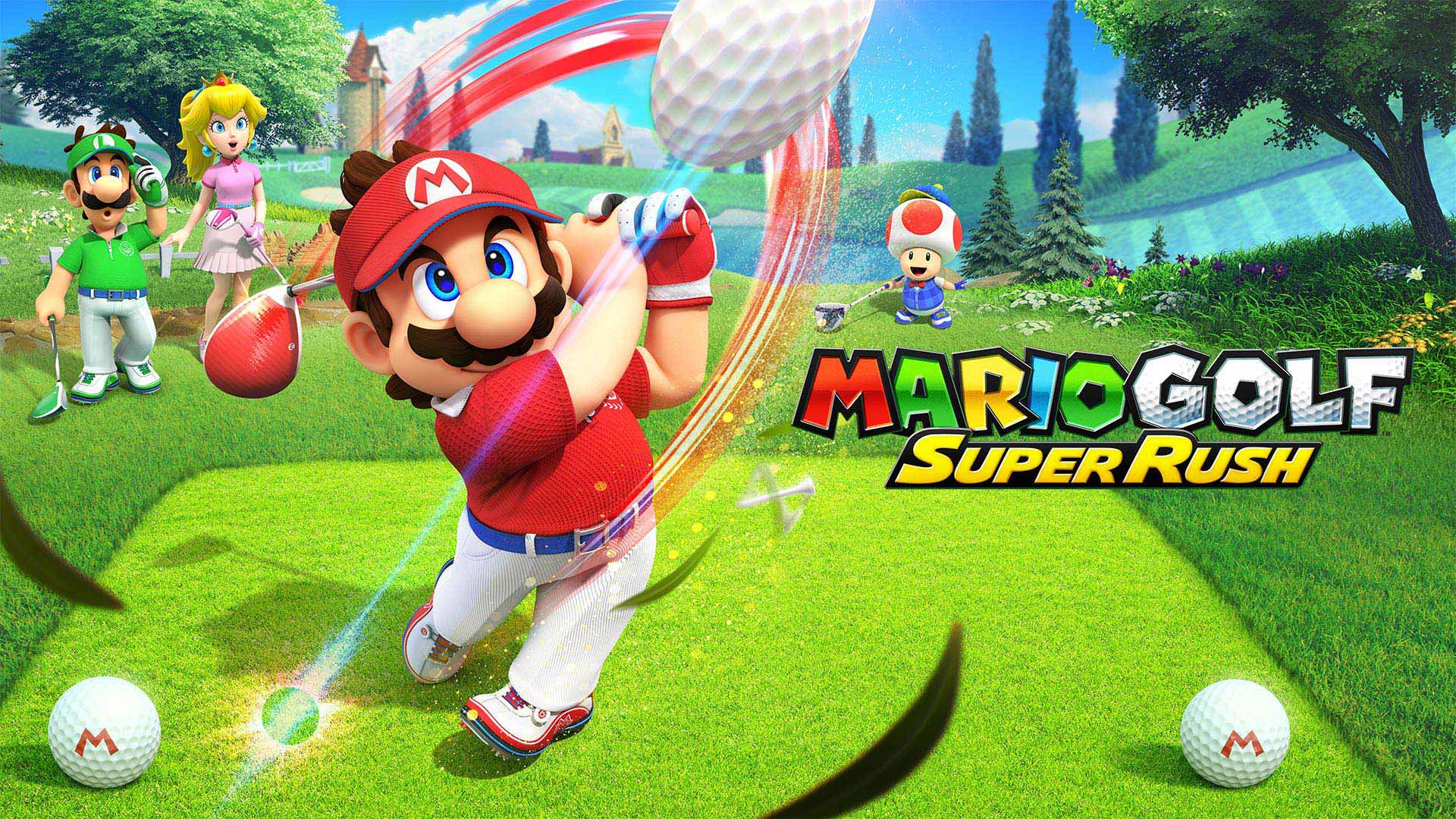
I have never played golf in my entire life. Not in real life, or virtually, despite several chances for both. So why I thought skipping through the instructions Mario Golf: Super Rush offers, and heading straight into a game was a good idea is beyond me. That doesn’t mean I didn’t have fun though. Mario […]
The post Mario Golf: Super Rush Review appeared first on 8-Bit Island.
]]>
I have never played golf in my entire life. Not in real life, or virtually, despite several chances for both. So why I thought skipping through the instructions Mario Golf: Super Rush offers, and heading straight into a game was a good idea is beyond me.
That doesn’t mean I didn’t have fun though.
Mario Golf: Super Rush is a golf game in the same way that mini golf is. From the outside looking in, there are quite a few similarities, and if you knew nothing about golf, you would definitely call it golf. It’s not though, because even in the most basic version of a round of golf, you still have super powered shots. Pauline uses a microphone stand as a club, and a small section of ‘Jump Up, Super Star’ plays when she does her special shot.
It’s a lovely nod to Super Mario Odyssey, but definitely not a legal move in golf. Even I know that.

All that said, if you want to try and play it as a proper golf game you can turn off special shots, and play it as a proper, albeit cartoonish, golf game. There’s a full selection of clubs, each with their own stats and examples of how they hit when you select them, and wind speed and direction to take into account.
Or you can play Speed Golf, and Battle Golf for some Mario Party level friendship destruction in half the time. One guess as to which modes I picked most often.

Speed Golf is normal golf but with the caveat that you have to race after the ball, can run into other people to make them slow down, and you’re timed during the whole thing. Taking risks, and hitting your ball out of the actual course can give you a huge advantage. Or completely ruin the hole, and your chance at par. It can also be played on a split screen at the same time as your friends rather than taking turns, which is as amazing as it is hectic.
Battle Golf is a race to be the first to sink a ball into a series of holes on what can only be described as a deadlier, golfier, Wipeout play field. It is also, in the game’s canon, something Mario does on the regular, and is a world champion at. Because of course he is. Explosions, falling hazards, and a general willingness of the other players to destroy you makes for a hectic, and fun time. Like any Mario game, the true treasure is the friends you lose along the way.

Just when you think that Mario Golf: Super Rush has shown all it can with three different play modes, all of which are well suited to online and split screen play, it throws a storyline into the mix. It’s not exactly a strong storyline, but it’s definitely there. Including a world where battle golf is televised, people are racist against ghosts, and the unsettling realisation that Birdo is taller than your average Mii.
The storyline isn’t all that long, and honestly drags a lot in the beginning. While a good way to learn controls, you are forced to play your way through several mini game style rounds of golf to practice your technique before actually hitting the green. I’d recommend playing the Golf Adventure first, or you never will.

This iteration of Mario Golf has a full roster of playable characters, including my new favourite to play as, Pauline. Walugi rocks out in a truly terrible fedora, Bowser tries his best to find golf wear for the giant dragon-bear monster he is, and Peach, as always, is the best dressed there. Each character has their own style and flair that makes picking your favourite Mario character actually mean something, either because they are stronger and can hit harder, or because their special shot gives you an advantage.
What Mario Golf: Super Rush has in character selection, it lacks in courses. There are six courses. Rookie Course, which you will never play after the first time unless you’re trying to 100% the game. Bonny Greens, a traditional golf course, and the last normal course in the lineup. Ridgeback Lake allows you to hit your ball onto small islands in an attempt to get to the hole faster but pairs that with clouds whose life work is the blow your ball off the course.
Balmy Dunes is one giant sand trap. Wildweather Woods tends towards winds, rain and thunderstorms, but you’ll be fine as long as you’re not holding a metal stick of some sort… And Bowser Highlands, features far too much lava to be OSHA compliant. It’s not the biggest selection of courses, but New Donk City should be coming later in a free DLC.

A great party game, or even just a satisfying, casual, solo game, Mario Golf: Super Rush is just plain fun. Though lacking in courses or story, it gets a hole in one (legally I must put in at least one golf joke in this review, I don’t make the rules) for being another good addition to the Mario franchise.
The post Mario Golf: Super Rush Review appeared first on 8-Bit Island.
]]>
Little Nightmares 2 brings more nightmares, more weird CGI claymation horror, more unsettling and gross noises, and for the first time a hand to hold. You play as Mono, a small boy with a paper bag on his head, helped by Six, the protagonist from the first game. If that’s reassuring, it probably shouldn’t be, […]
The post Little Nightmares 2 Review appeared first on 8-Bit Island.
]]>
Little Nightmares 2 brings more nightmares, more weird CGI claymation horror, more unsettling and gross noises, and for the first time a hand to hold.
You play as Mono, a small boy with a paper bag on his head, helped by Six, the protagonist from the first game. If that’s reassuring, it probably shouldn’t be, since nothing in the Little Nightmares world is particularly nice. You can hold Six’s hand and lead her places though.
That’s kind of nice, right?
Slightly Larger Nightmares
Little Nightmares 2 allows you to explore the larger Little Nightmares world. You’re no longer restricted within the cramped and confined Maw from the first game. Instead you get wide open fields, houses, and underground tunnels to explore.
Spoiler alert, when you’re a tiny child, it sucks just as much as the Maw did.
Where Little Nightmares used confined spaces to build up tension and make you feel like you were being led into imminent danger, Little Nightmares 2 uses wide open space to make you feel like there’s nowhere safe to hide. That’s not to say that you won’t be hiding and creeping silently, but with so much more variety to your surroundings, you’re often left scrambling to change tactics on the fly. It’s a very effective way to build a feeling of dread, and uneven odds.
As if being a third of the size of the adults in the world wasn’t enough.
Nightmare Fuel
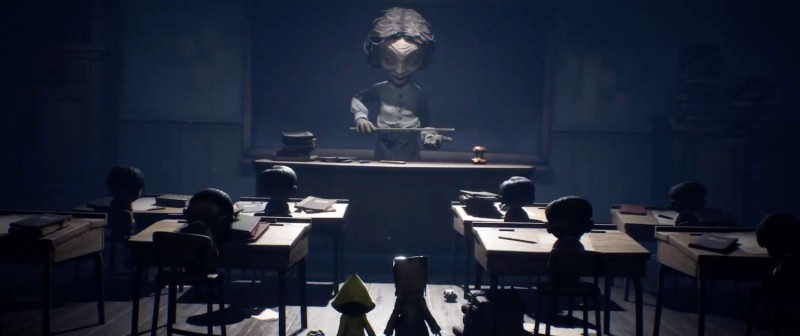
As always, Little Nightmares 2 features creepily detailed CGI claymation models that are horrifying in both their detail and design. From Classy Slenderman to Evil Elastigirl, there are a range of new antagonists trying to make Mono and Six’s lives more difficult. Not only do they look awful, but they’re excellently animated to make sure that they hit that primal part of your brain that does not like jittery, and unnatural movements.
It’s a couple of turns past the Uncanny Valley, right into Nightmare Fuel territory.
The audio design is amazing, giving you a range of gross, squishy noises at the perfect time to give you the creeps. Terror creeps in when dull thumping sounds from the next room mean you’re either about to see the Hunter walking about or, just as likely, something banging its head against a wall.
Or someone else’s head. Whichever is worse… it’s definitely that one.
Fight the Night(mares)

Little Nightmares 2 builds on the puzzle/platformer action of the first game. While it does rely a little too heavily on a ‘try and die’ mechanic to solve some puzzles, overall, Little Nightmares 2 brings about interesting puzzles with satisfying solutions.
This time around, however, Mono allows you to use weapons. Weapons that are heavy enough to do damage, but also heavy enough to make sure you’re only able to do slow, calculated swings. In other words, don’t miss, because a weapon really doesn’t make you that much safer.
What it does let you do is search hidden areas for traps, face down some of the smaller bad guys, and even brute force a few obstacles. Having Six as your AI companion also allows for a range of new puzzle solving solutions, like getting up on high ledges, or pulling two levers at once. As an added bonus, Six is actually a very competent companion. She’s even nice enough to point you in the right direction if you’re having a hard time. How considerate!
The New Nightmare
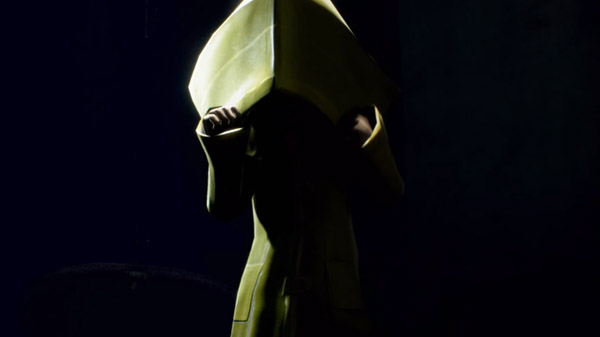
If you enjoyed Little Nightmares, then playing Little Nightmares 2 should be a no brainer. It’s more of the creepy and unsettling horror we’ve come to love/hate, with slightly more refined controls, a few new mechanics, and a rather heartbreaking story.
If you’re new to the franchise, you may experience a little bit of a learning curve, but should be able to pick up and enjoy Little Nightmares 2 easily… As long as you can bring yourself to keep playing, of course.
The post Little Nightmares 2 Review appeared first on 8-Bit Island.
]]>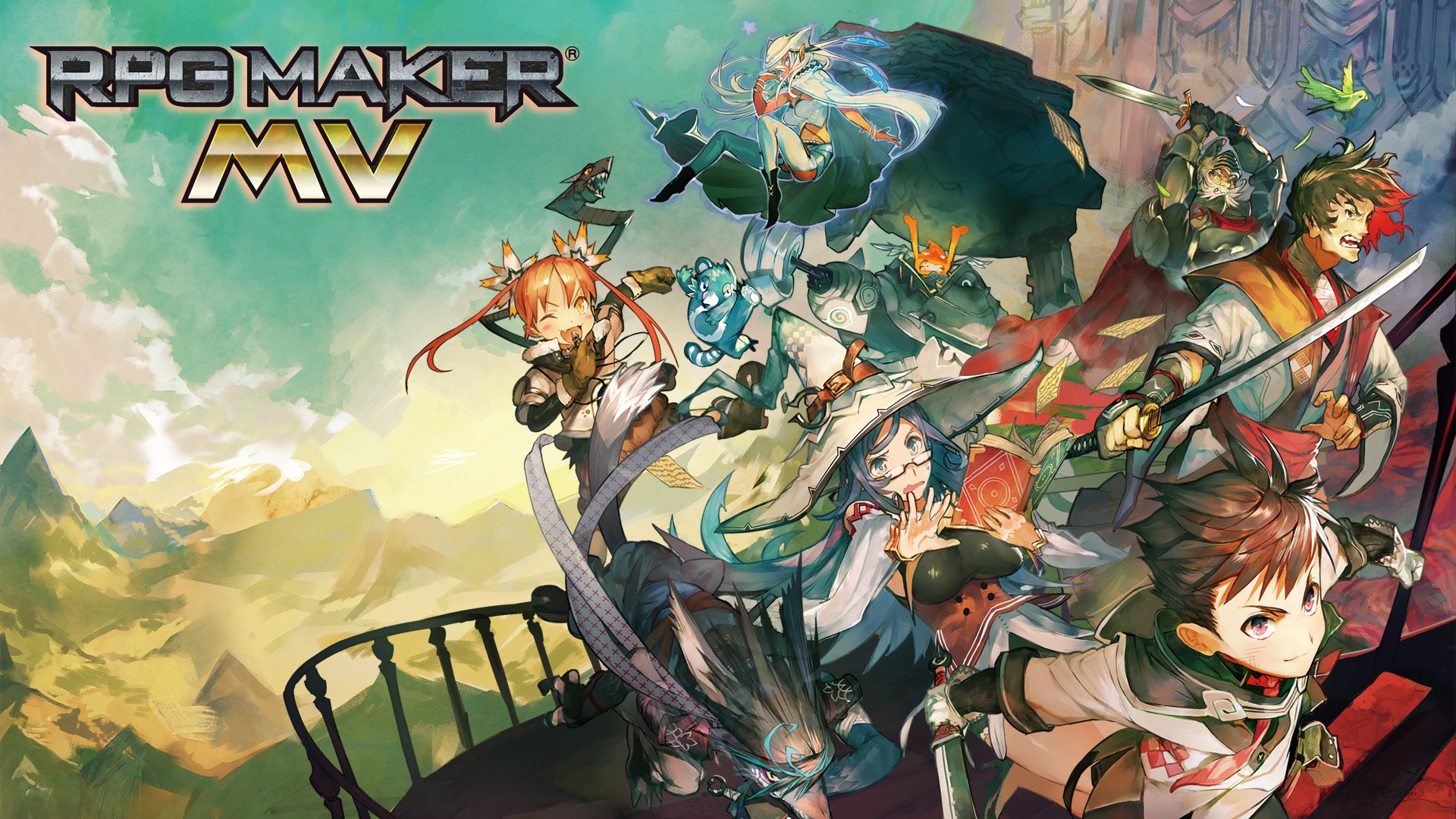
The RPG Maker franchise has always given us an easier way to get into game development, which out having to invest is powerful computers, and heaps of coding classes. Now, with RPG Maker MV, it brings that ability to the PS4 and Nintendo Switch. Originally out in 2015 for PC, 2018 for PS4 and Switch […]
The post RPG Maker MV Review appeared first on 8-Bit Island.
]]>
The RPG Maker franchise has always given us an easier way to get into game development, which out having to invest is powerful computers, and heaps of coding classes. Now, with RPG Maker MV, it brings that ability to the PS4 and Nintendo Switch.
Originally out in 2015 for PC, 2018 for PS4 and Switch in Japan, and now, as of September of 2020, we’ve got the PS4 and Switch version in New Zealand. The real question is does it make the transition from PC to console, and is the future really here with game development on the go?
The RPG Maker series has always been a fan favourite, allowing game enthusiasts to explore their creative side and tell rich stories without having to know coding. Or at the very least, much coding. To the Moon, Corpse Party and The Witch’s House are just a few of the success stories RPG Maker has seen in recent years.
That success does take a lot of effort, however. Don’t be fooled by the fact that RPG Maker MV presents itself as a game, it is still definitely a complicated piece of software that needs practice. Be prepared to sink some serious hours into it if you want to create your masterpiece.

RPG Maker MV boasts a lot of improvements over the previous entries in the series. For the first time Javascript is used rather than Ruby, allowing for more in depth control over the game you create. More experienced developers will be able to easily change game UI, and overhaul battle mechanics.
The sprite generator has a lot of new features (facial and otherwise) that makes creating a character not only a breeze, but also a lot of fun. Each change is reflected in real time, and with enough variety that it does truly feel like you’re making a new character each time. You also won’t be surprised by one emotion causing your sprite to look monstrous because it’s all on screen right there for you to check from the get go.

For the first time ever, RPG Maker MV also sees cross publishing when made on PC. Games created on PC can be released on both PC and mobile, while both PS4 and Switch games have to stay the same as the creation software which is a bit of a let down.
The fact that you can only share Switch made games with other Switch users is only the beginning of the disappointing cutbacks that had to be made in order to port RPG Maker MV to the Switch.
The lack of cross publishing means two things. One, all those really amazing RPG Maker MV games you’ve heard of might not have been remade on your console, and two, there is a limited pool of games to play. That being said, RPG Maker MV Player is free to download, and if you’re a fan of RPGs, and indie developers, it’s well worth downloading a game or two.
If you’ve managed to create a game, and feel pretty confident that people would pay to play it, there’s a bit of bad news. You won’t be quitting your job anytime soon, since both the Switch and PS4 versions of RPG Maker MV don’t allow you to sell the games you make. This is likely more to do with the hoops you’d have to jump through to get the game off the console it was made on.
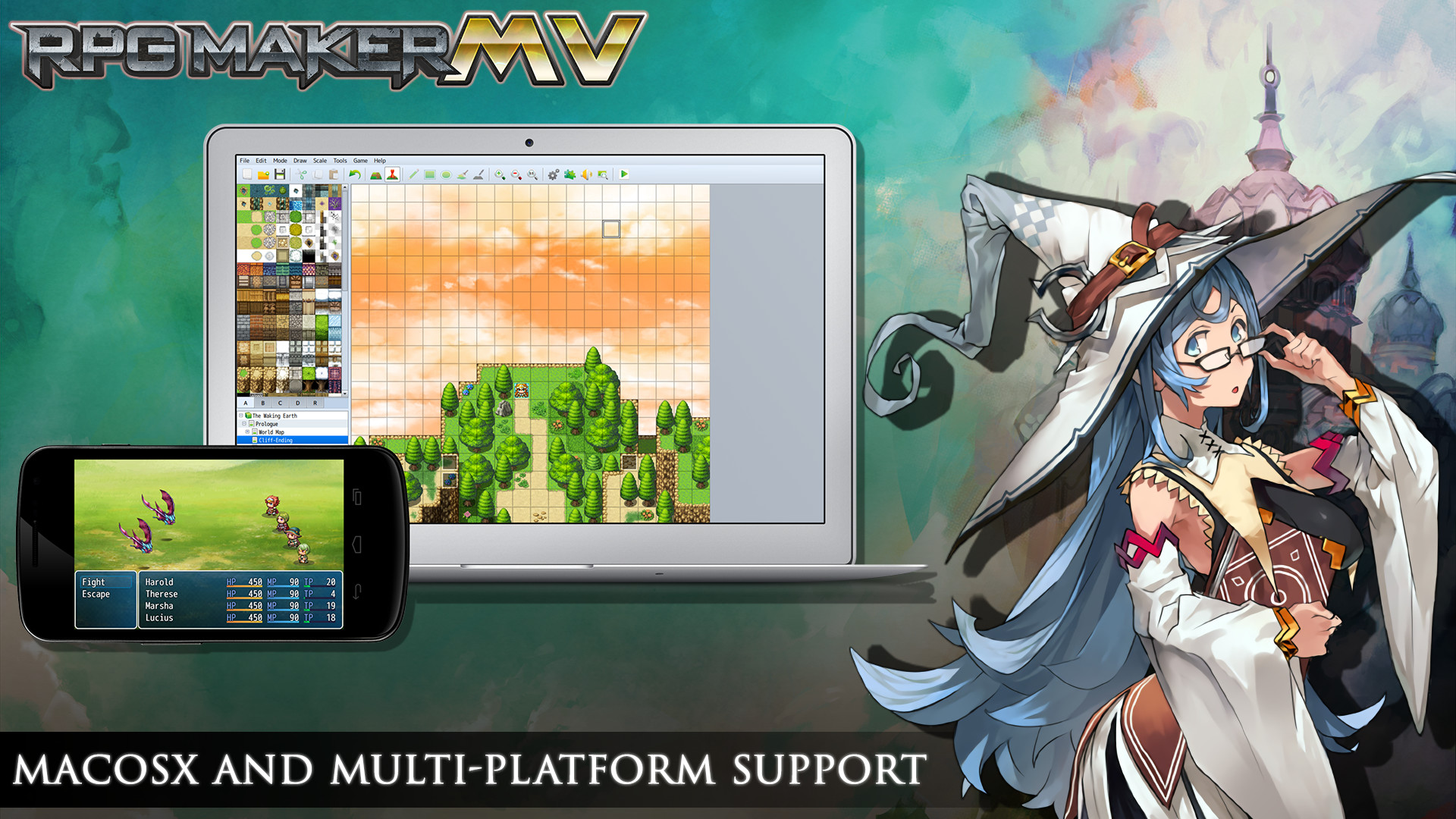
As anyone who has ever added mods to a PC game can tell you, there is a world of talented people out there who will create assets for games and franchises that they like. The same is true of RPG Maker MV, and on PC there is a lot of community content that really allows you to create the game you want. You don’t see this on Switch or PS4, as neither can natively have data externally added to a game. There are, however, some wonderful creators who have made games that act as tutorials, or offer cool tips for new users.
The software itself suffers some performance issues on Switch. Navigation through menus is surprisingly intuitive. You click one button to enter a menu, and another to click out of it, while you use the joysticks to move through the menus themselves. They can be laggy at times, but still manageable.
There are two main reasons you’d buy RPG Maker MV on Switch. You have a Switch and don’t want to shell out a grand plus to buy a PC or you would like game creation on the go. If its the latter, don’t bother even trying.
Imagine starting up a new game. Imagine starting the tutorial. Imagine that tutorial crashing the game, and finding out that it cannot be accessed again through any menus and you have no idea what to do. Multiple times, on multiple Switches.

While stable enough in docked mode, the last thing you want for your game development software, is to have it crash on you. Especially ive you’ve not saved recently.
RPG Maker MV is a really lovely game development kit, made better by the hoards of fans who want to share their love for the franchise. But with the stripped back features, and tendency to crash in handheld mode, it was not ready to be released on Nintendo Switch.
The post RPG Maker MV Review appeared first on 8-Bit Island.
]]>
The Fitbit Versa 3 offers a range of helpful tools by combining a fitness tracker and a smart watch for the on the go, busy person… Or someone like me who thought it’d be cool to know my resting heart rate and just discovered the rest along the way. And boy there was a lot […]
The post Fitbit Versa 3 Review appeared first on 8-Bit Island.
]]>
The Fitbit Versa 3 offers a range of helpful tools by combining a fitness tracker and a smart watch for the on the go, busy person… Or someone like me who thought it’d be cool to know my resting heart rate and just discovered the rest along the way. And boy there was a lot to discover, such as my heart rate rests higher at work than when I’m at home.
Ah, capitalism.
The Versa 3 offers a range of health tools, from heart rate monitoring and steps taken, to menstrual tracking and mindfulness. Optionally the app also let’s you track water and calorie intake, and also helpfully tells you how many calories you’ve burnt so far that day. The most interesting for me however, was the sleep tracker.
If worn while sleeping, the Versa 3 will keep an eye on your heart rate and breathing patterns, which definitely sounds like a weird dystopian future, but it also means that it can track your sleep cycles. I’ve never been a particularly good sleeper, so being presented a graph of how my sleep cycles between light, deep, REM and being awake gives me some insight.
I have no idea what to do with that insight, but I definitely have it!

The best part about the sleep tracking is the alarm. The Versa 3 has a vibrate alarm that gently nudges you awake without loud noises. It can also be set to wake you up at the best part of your sleep to ensure you won’t wake groggy. You know, how you feel when your cat wakes you to insist that they be fed RIGHT NOW at 3am. Once you set your alarm, it will go off within the half hour before you’ve set whenever the best time for you is. Just make sure to test the vibrate alarm before you trust it for work, or that important flight; if you’re a heavy sleeper, it might not get you up.
Along with all the neat health tools, the Versa 3 is also a very functional smart watch. You can receive calls on it, but will need to boost the volume and take the microphone off mute first. Once you’ve got it all working however, it offers a reasonable sound and mic quality, even if you do have to walk around with your wrist at approximately chum level.
You can also read and answer texts with a selection of premade options. Options that can be customised with any short answer you want. Any answer you want. Be as mature or as immature as you feel inside.

There are a lot of hidden gems on the smartwatch side of the Versa 3. Find my phone, for example makes your phone chime out, even if it’s on silent. You can control your Spotify from your wrist, but not play music through the actual watch, and in true smart technology fashion, you can even pay by waving your wrist at a pay wave machine.
As far as smart watches go, the Versa 3 offers it all at a reasonable price when compared to the Samsung and Apple watches on the market, and has all the health tools to boot. You can even download an app to roll D&D dice, just in case you forget yours or have a surprise tabletop game waylay you.
Speaking of surprises, you don’t need to fear a sudden downpour, or worry about taking your fitbit off while you swim or shower. Advertised as ‘swim proof’ rather than waterproof for what I can only assume is legal reasons, it did hold up well in the shower and doing dishes.
I wouldn’t say the Versa 3 is designed for use in the shower, simply because the hot water hitting the touch screen seemed to confuse it a lot, causing a lot of random menus to be opened and closed. It ended up just freezing a bit, and turning the screen on and off instead. It did seem to get over it after a minute and a quick dry off though.

The Versa 3 manages to not only be very useful, but look good doing it. I had the gold case and midnight blue band, which looked very striking together. I definitely had a few jealous friends. Unfortunately the band comes in a matte finish, which feels nice on, but has already started to rub off around the edges after only a month.
A month is also how long it took for ‘Leah P’ to try to friend me via the fitbit app, so we could compete against each other for how many steps we could do. Which is actually kind of cool, and with a group of people, or even just one friend to compare yourself to I found it much easier to motivate myself to take the long way round to get those last few steps. Sadly Leah is not a real person. I know this because she had an average step count of “- -“, which I can only assume means she has never used the fit bit app, and because she does not like to wear shirts.
Am I being subtle enough? She was a porn bot, and not nearly as interested in matching steps with me as she originally promised.

If all else fails and you just can’t get into the step tracking, or the ability to read tiny emails on your wrist, there is a huge selection of watch faces. From Christmas themes, to Animal Crossing. From the PokeWatch to the Eiffel Tower, rainbows and famous art pieces, there will be at least one design that takes your fancy. Even if you only used it as a watch, at least it would look good at the same time.
The post Fitbit Versa 3 Review appeared first on 8-Bit Island.
]]>
Greta Gerwig showed us in 2017 that she knows how to make a moving, powerful, and most importantly, realistic female coming of age story when she delivered Lady Bird. So it comes as no surprise that she was called upon to screen write and direct one of the most well known female coming of age […]
The post Little Women (2019) Blu-ray Review appeared first on 8-Bit Island.
]]>
Greta Gerwig showed us in 2017 that she knows how to make a moving, powerful, and most importantly, realistic female coming of age story when she delivered Lady Bird. So it comes as no surprise that she was called upon to screen write and direct one of the most well known female coming of age stories out there. Translated into more than fifty languages, there are few places that Little Women hasn’t landed and fewer still people who haven’t been moved by some part of it. I know I was. I cried four times, and I’m still not sure if I’m embarrassed by that or not.
Jo’s gonna be ok, right?
The March sisters Jo (Saoirse Ronan), Meg (Emma Watson), Amy (Florence Pugh), and Beth (Eliza Scanlen), are our main characters with Jo being the narrative lead. Each actor takes to the role perfectly, embodying their characters, and bringing them to life. Even Amy, generally considered the least likeable sister is well played, and relatable. Joining these wonderful actors are Meryl Streep, Laura Dern, and Timothée Chalamet who all bring their best, and make even the unlikeable Aunt march (Meryl Streep) a delight to watch (even as you not so secretly disagree with her ruthlessness).
Gerwig took the story that Louisa May Allcott wrote, and mixed in a healthy dose of reality. Taking inspiration from Allcot’s life, Gerwig brought Little Women into a more modern time, not in setting, but in feeling, and this comes from the fact that the Allcott’s were an extraordinary modern family for their time. Described as an “intellectual hippie family” by Gerwig, the Allcott’s encouraged all of their children to see themselves as equals to men when that was not the given assumption, and while that is not as big an issues as it used to be, there is a universality to Jo March’s need to both find her place, and refuse to settle just because others tell her to.
They were no longer little girls, they were little women

As with any adaptation, a certain amount of love for the original text must be packaged into the work. Gerwig shows that love for Little Women in a variety of ways. Filing with 35mm film, rather than digitally, filming in Concord, and working closely with the Orchard House so that both she and her set designer could get a feel for the March/Allcott house.
What really set Gerwig’s Little Women apart is the mixed up timeline. Rather than telling the story chronologically, Gerwig jumps around, clearly linking the past and present, and showing the coming of age aspect of Little Women in a different light. Instead of the gradual change of characters as they grow, you are given up front the start and the end. Both ways show you the character journey, and the importance of it, but by telling it out of order the direct links between childhood and adulthood become so much clearer. It’s hard to stay mad at a bratty Amy, when in the next scene she is doing her best to marry well to provide for her family, and struggling with her own doubts and inadequacies.
Not so little extras

The Blu-ray release also comes with several features, all of which are rather delightful to watch, and definitely give an appreciation for how much work and care went into this retelling of Little Women.
• A New Generation of Little Women, A dive into the characters and the actors playing them, as well as Gerwig’s changes to the story and her inclusion of Allcott’s history into Jo’s character.
• Making a Modern Classic. A look into the process of making Little Women with a focus on the importance of the Allcott house, costumes, and using 35mm film in production.
• Greta Gerwig: Women Making Art. A deep dive into Gerwig’s process during filming, as well as her personal connection to Little Women.
• Hair & Make-Up Test Sequence. A glimpse of raw footage and pre-production design tests.
• Little Women Behind the Scenes. A ‘making of’ about the film, mostly repeating content front he other features, just to a lesser extent.
• Orchard House, Home of Louisa May Alcott. A look around the house Louisa May Allcott grew up in with her sisters, the personality embedded in it, and how small parts of the real house made it into the movie, along with some of the house’s history.

The post Little Women (2019) Blu-ray Review appeared first on 8-Bit Island.
]]>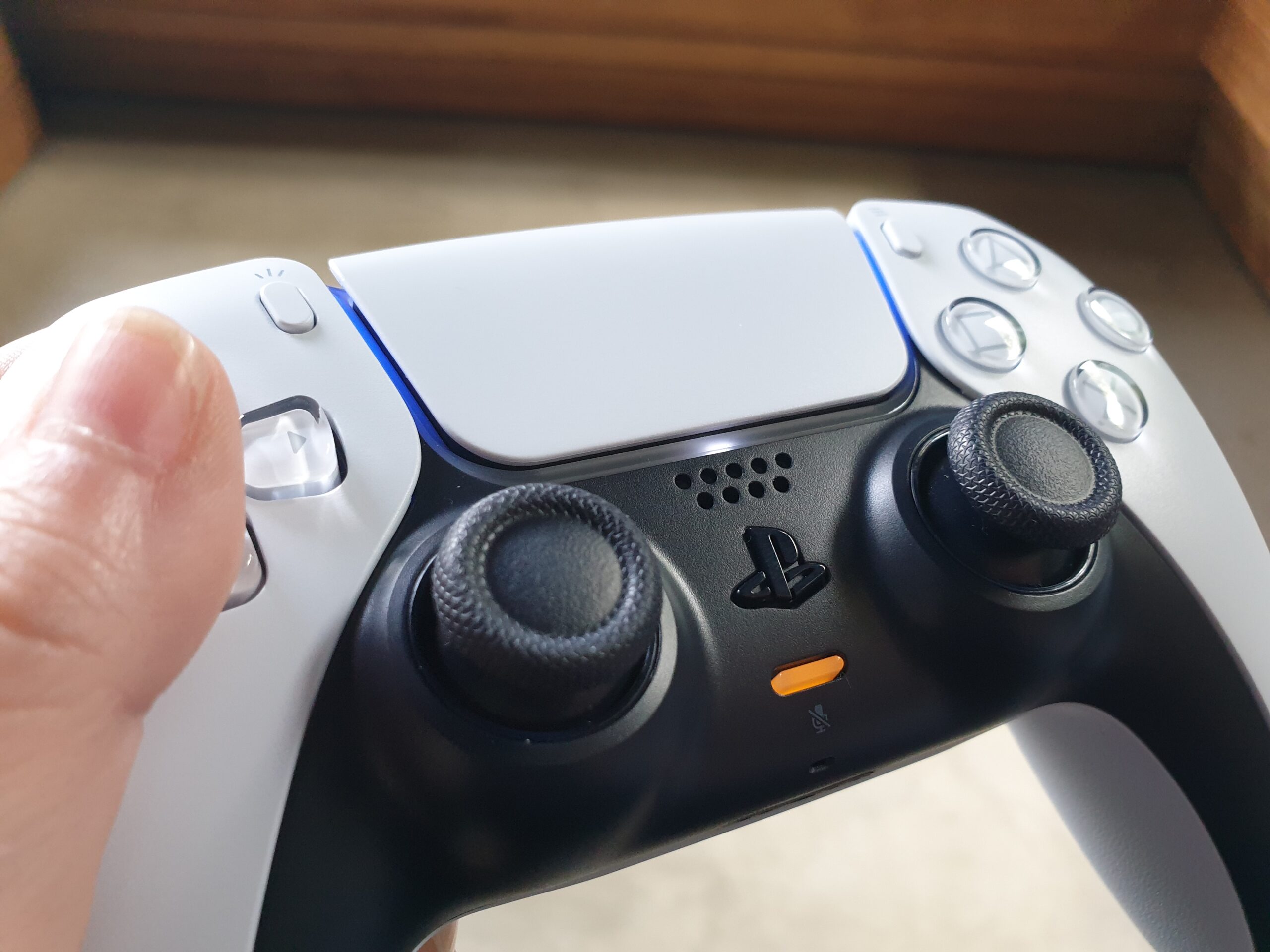
Let me paint a picture for you. It’s a brisk Auckland morning, and I approach an unassuming white villa, in the middle of the street. My temperature is taken via a thermometer gun, and I can go in. I am met with neon blue lights lining the hallway floor, and a lounge with one of […]
The post Hands on with the DualSense Controller appeared first on 8-Bit Island.
]]>
Let me paint a picture for you. It’s a brisk Auckland morning, and I approach an unassuming white villa, in the middle of the street. My temperature is taken via a thermometer gun, and I can go in. I am met with neon blue lights lining the hallway floor, and a lounge with one of the largest TVs I have ever seen. Appropriate, considering the console sitting next to said TV is also the largest console I’ve ever seen.
I’m talking about the PlayStation 5.
Pretty as a picture
Somehow both bigger and smaller in person, the PlayStation 5 cuts an impressive figure. Yes, it is tall and wide, but it also comes together with sleek lines that fool you into thinking it is a lot more streamlined than it actually is. Pictures cannot do it justice, and while I’m still not completely sold on the white colour scheme, the overall design hits right. It’s new and interesting, and while I’m not 100% sure where to put it, I know that a PlayStation 5 will look good on display in my living room.
A monolith of a TV to match a monolith of a console; what more could a girl want?
Oh, to actually play on the PlayStation 5? Well, that makes sense.
I was given a go at the Astro’s Playroom demo. No loading into the game, it was already prepared for me, so I can’t give you any sneaky information about the UI, or even how quickly the game loaded from start up.
What I can tell you, is that Astro spends his spare time with all the other Astro bots knocking around inside your console, shooting other bots with arrows, and climbing up things he probably shouldn’t climb up. At least he did when I controlled him.
Getting to grips
While the demo didn’t show off any deep and engaging story, it did allow a lot of exploration and jumping. It’s a fun platformer to mess around in. The demo includes free reigns to the hub world, one of the levels, and the Labo area, which is basically a PlayStation nostalgia trip on steroids. I won’t give anything else about Labo away, because it is better experienced than explained, but it is a nice touch and shows that Sony cares about where it comes from, even as it changes.
Talking about changes, do you remember when they announced that the new controller would be called the DualSense, rather than the expected DualShock 5? I do, and I didn’t even really pay attention.
It’s impressive how much they have improved the controller. The name change is well deserved, because as soon as you have it in hand, you can tell that the DualSense is an entirely new beast.
Let’s start from the outside and move in. The DualSense is shaped differently. The back features a textured grip that makes holding it over a long time much easier. It is also made up of hundreds of little PlayStation symbols as a nice added touch. The arms (or whatever you want to call the part of the controller that you actually hold) are less round than the DualShocks, and instead arch in the back, meaning that they sit nicely in the centre of your palm. That also changes your grip to be slightly leant out, rather than in as most PlayStation users will be used to. It’s different, but a very natural fit.
Click me a winner
Improvements have also been made to the DualSense’s thumbsticks. While still not completely concave, the edges are heavily textured, and a little bit deeper than the DualShock. While not a dramatic difference, it was definitely noticeable, and will make the thumbsticks less slippery. Something I sorely need when I am intensely focused, and a little bit stressed out during a game of Crash Bandicoot 4.
Let’s talk about adaptive triggers. The first time I came across it, I thought I had broken the controller. A sure fire way to not get invited to anymore events. Thankfully that was not the case.
Adaptive triggers basically means that the triggers can feel different depending on what weapon you’re using, or in the case of Astro’s Playroom, what item you are crushing. And I’m not talking about the controller sometimes just letting you press in half way and that’s it. I’m talking about the freedom to make that trigger feel like whatever the game developer can imagine. A tin can is a jagged, incremental press of the trigger. A lot of small clicks until the can is nothing more than flat tin. A plastic capsule however is a lot of pressure and tension until a sudden crack makes the plastic give way.
Drawing a bow, shooting a minigun, and pulling a lever also all felt different from crushing cans and plastic capsules, and I can’t wait to see what other developers use the adaptive triggers for.
One of the main reasons for the name change to DualSense seems to be the rumble feature. That is to say, there isn’t one. Instead the DualSense uses haptic feedback. You know, that slight buzz your phone gives when you type. Only I never knew it could be this good. Swimming, walking through grass, pulling up cables, and skating on ice all feel dramatically different. While I’m sure some of it is a trick of the mind, the feedback also seems to match the movement. I’ve never been ice skating because I am a very clumsy person, but I am now very sure of what it would feel like.
After you’re finished being impressed with all that, let’s add in my favourite feature of the DualShock 4. The speaker in the controller.
The speaker in the DualShock 4 was great. When you shook the controller in The Last of Us you could hear batteries rattle around. When the police radio comes through your controller in Need for Speed Payback, you know you’re in trouble. Or when your character in Fat Princess Adventures would start talking to you through the controller if you put it down for too long.
But do you know what’s even better than that? All of the above, but with the added bonus of hearing the difference between Astro walking on metal, sand or glass. The sound of wind blowing in a sandstorm. Gentle splashes as you swim, or the gentle rustle of grass as you walk through it. Sound though the controller is clearer, and the little touches mean that the game always feels that much closer to you.
As if one of those new additions to the DualSense wasn’t enough, all of them together make an impressive piece of technology that was created with the intention of putting you as deep into the game as possible.
If I wasn’t excited for the PlayStation 5 before, I am now. The DualSense controller is an impressive step up from the DualShock 4 and as the part of the set up that you put your hands on regularly, it’s going to make gaming that much more immersive.
I can’t wait to see the future of gaming.
The post Hands on with the DualSense Controller appeared first on 8-Bit Island.
]]>The post Infini review appeared first on 8-Bit Island.
]]>Wait, what?
Literally about Hope. You play as the anthropomorphic personification of hope. A winged humanoid creature who is stuck in Infinity, and wants nothing more than to get out, even if that seems impossible. The story plays out in a non-linear fashion, dancing around ‘the incident’ which first saw Hope trapped in Infinity. Along the way you will meet a range of other characters such as Technology, who has a wheel for a head, Memory, a helpful elephant and War. He has a gun face, because of course he does.
Infini looks, for lack of a better term, weird. It is hand drawn, with painted backgrounds, and while I’d like to be a bigger person and say I found it charming, I did not. It unsettled me in the same way that Salad Fingers, and Don’t Hug Me I’m Scared did. Yes, that is a telling reference to the deep YouTube holes I have found myself in, and no I do not recommend them.
Infinite dreams
Infini has what I like to call dream logic. It shouldn’t make sense, but it just does in the same way you don’t question dreams while you’re having them. So while the plot jumps around, leaving you confused, it’s much easier to just go with it and assume however you choose to understand the symbolism and story is correct.
You’re not playing for the story anyway, it’s all about the trippy visuals, and on point gameplay. The story is just the mayonnaise in the chocolate cake. It makes it better but if you think about it too long, you’ll forget you have a chocolate cake.
Infini is also a game figuratively about hope. Hope never gives up. Even 999,999,999 days after the incident, when he is emaciated, wingless, and missing an arm. It’s oddly charming, and honestly a refreshing reminder that sometimes you just need a little bit of hope and endurance, especially in the current world climate. For a character that unnerves me, I’m surprised how easy it is to connect with Hope, and his struggle to break out of a pattern.
Zoom zoom zoom
Hope falls from the top of the screen to the bottom, and loops back around to do it all over again. Your goal is to get him into a portal without touching the barriers. Barriers form the level layout, and serve as the major obstacles you need to navigate around.
Here’s the trick, those barriers aren’t there if you can’t see them. And boy, that is some sort of motivational speaker’s tagline about life and I’m definitely not willing to unpack that in a game review.
Aside from controlling your fall speed, the first trick you learn in Infini is how to zoom out in the level. This opens up the whole level so you can see the possible paths to take. This is also how you make barriers appear and disappear. The trick is knowing where to position yourself, and how far to zoom out.
Got that? Good.
Now forget it all, because in a twist that not enough puzzle games utilise, once you’ve mastered the tricky shifting of perspective, you won’t need it for a few levels when you go back to basics. I am not a gamer prone to rage, but I had to put my switch down when I realised I had been overthinking everything.
Gravity plays favourites
At least I’m not alone. Infini has definitely been overthinking too. Zooming is not the end of your abilities. Flying, changing the direction of gravity, and hovering are just the beginning. My personal favourite, despite how much it hurt me, was the ability to switch between different dimensions which had different layouts of barriers. Move in one so that you can slip into the second without crashing, and so on and so forth.
With all the dimensions Infini seems to have, you’d think there would be one where the game doesn’t give me a headache or an existential crisis. And yet here we are.
As a spatial puzzler, Infini is unique. Even if you ignore the weird visuals and music, and the deep and far too meaningful story that I still don’t quite understand, the gameplay itself is interesting and captivating. It was a frustrating delight to play, and if you haven’t given it a go, you’re missing out. I’m not sure on what, exactly, but it’s something.
The post Infini review appeared first on 8-Bit Island.
]]>